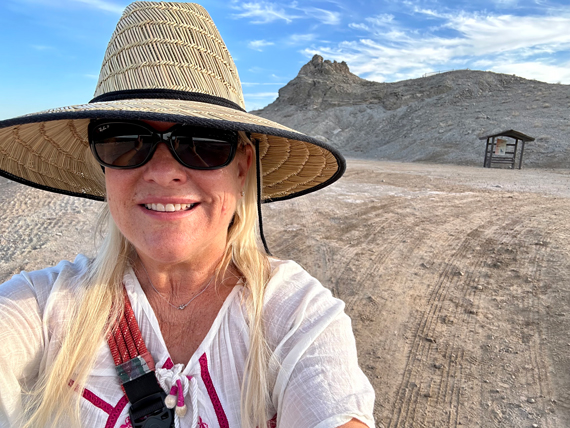|
Integrating Tribal Cultural Resources into CEQA Analysis: A Long Journey Home
By Courtney Ann Coyle
May/June 2025
Editor’s note: Courtney Ann Coyle is a San Diego attorney with a statewide private practice. She is former chair of the City of San Diego Historical Resources Board and a current member of the County of San Diego Historic Site Board.
 Courtney Ann Coyle (right) and Carmen Lucas (Kwaaymii Laguna) at a California Truth and Healing Commission meeting at the Manzanita Ramada on the Manzanita Band of the Kumeyaay Nation Reservation, December 2023. Coyle, Lucas, and three others received a 2023 Governor’s Historic Preservation Award and a 2023 SOHO People In Preservation Cultural Keeper Award for the Ah-Ha’ Mut-ta-ti’ e Traditional Cultural Property Evaluation Report, which focused on sacred Kwaaymii/Kumeyaay land around and up to the venerated peaks of Mount Laguna in the Cleveland National Forest. |
 Courtney Ann Coyle in the field at Rock Hill at the Sonny Bono Salton Sea National Wildlife Refuge, a cultural landscape feature within the Southeast Lake Cahuilla Active Volcanic Cultural District, July 2023. Photos by Courtney Ann Coyle |
The San Diego region has always been a wonderful place to live: great climate, diverse species, beautiful coastal environments, and refreshing canyons. This has been true since time immemorial, a time long before European contact. Manifest Destiny displaced local tribal peoples, away from coastal areas. But their descendants and the resources that continue to connect them remain on and in the soils of our community, bridging the generations. How are these irreplaceable resources being managed? What will continue to live on to teach future generations of California Indians? How can we show respect that the Old Ones will not be forgotten?
In 2015, the California legislature passed AB 52, which acknowledged that land development processes had not adequately taken into account tribal views. It added a new category to the California Environmental Quality Act: tribal cultural resources, apart from archaeological resources. Tribal cultural resources were to be identified and evaluated by tribal expertise, which would also inform what should be protected from impacts and how to mitigate harms that could not be avoided. While not taking archaeology away from archaeologists, the category was meant to create a separate lane for tribes to be active participants and directly inform land-use planning and development processes through timely and meaningful consultation with lead agencies.
During the implementation of AB 52 over the last ten years, however, tribal practitioners have observed that there remain sticky barriers to full implementation. These include a persistent conflating of archaeological and tribal surveys, archaeological expertise still being placed above tribal expertise, and a failure of many jurisdictions to fully integrate tribes and tribal expertise into their CEQA processes.
Further plaguing true consideration of tribal cultural resources are all too common aspects of archaeological practice. Some principal investigators do not complete reports on sites they have studied; fail to submit reports to state Information Centers, depriving tribes and researchers of data access; or apply only archaeologically focused mitigation to tribal cultural sites.
Studies focused only on project boundaries and not the true extent of the resource’s significance have also contributed to a scarcity of data synthesis across studies to the detriment of tribes and tribal cultural resources. Also, relying exclusively on studies or management plans developed prior to AB 52’s adoption in 2015 runs the risk of never having the benefit of tribal input and review.
An example came before the City of San Diego’s Historical Resources Board in September 2024 regarding a cultural site at Otay Mesa that the board was asked to consider for historic designation, prior to its potential destruction for a housing development. While an archaeological perspective on the resource was provided, information summarizing the outcomes of exchanges between city consultants and the tribes was not included in the analysis despite two Kumeyaay bands having requested in writing to be included in the site’s interpretation and development of mitigation measures.
Further, the report before the board noted that over 1,700 artifacts had already been removed from the site, but no information was provided about where the collection was being stored or curated. Finally, while the site had been examined under HRB Criterion A as a special element of San Diego’s archaeological and cultural development, the report failed to clearly reference the site’s value to the Kumeyaay, thereby missing a crucial aspect of analysis required under AB 52. Had such information been timely analyzed, options for preservation in place could have been better considered.
While some progress has been made by lead agencies and is commendable, more needs to be done to meet the California legislature’s intent in recognizing tribal cultural resources. A bill to accomplish that, also aptly named AB 52, was introduced this year (2025). Because of issues related to tribal federal recognition status, it won’t be considered until 2026. While thorny recognition issues, not caused by tribes themselves but by past harmful federal and state extermination policies, are being worked out, it is hoped that the bill’s necessary further improvements to the CEQA process will be elevated, supported, and implemented. We owe that to our tribal partners and the beautiful place we call home.
BACK to table of contents
|
2025
2024
2023
2022
2021
2020
2019
2018
2017
2016
2015
|





